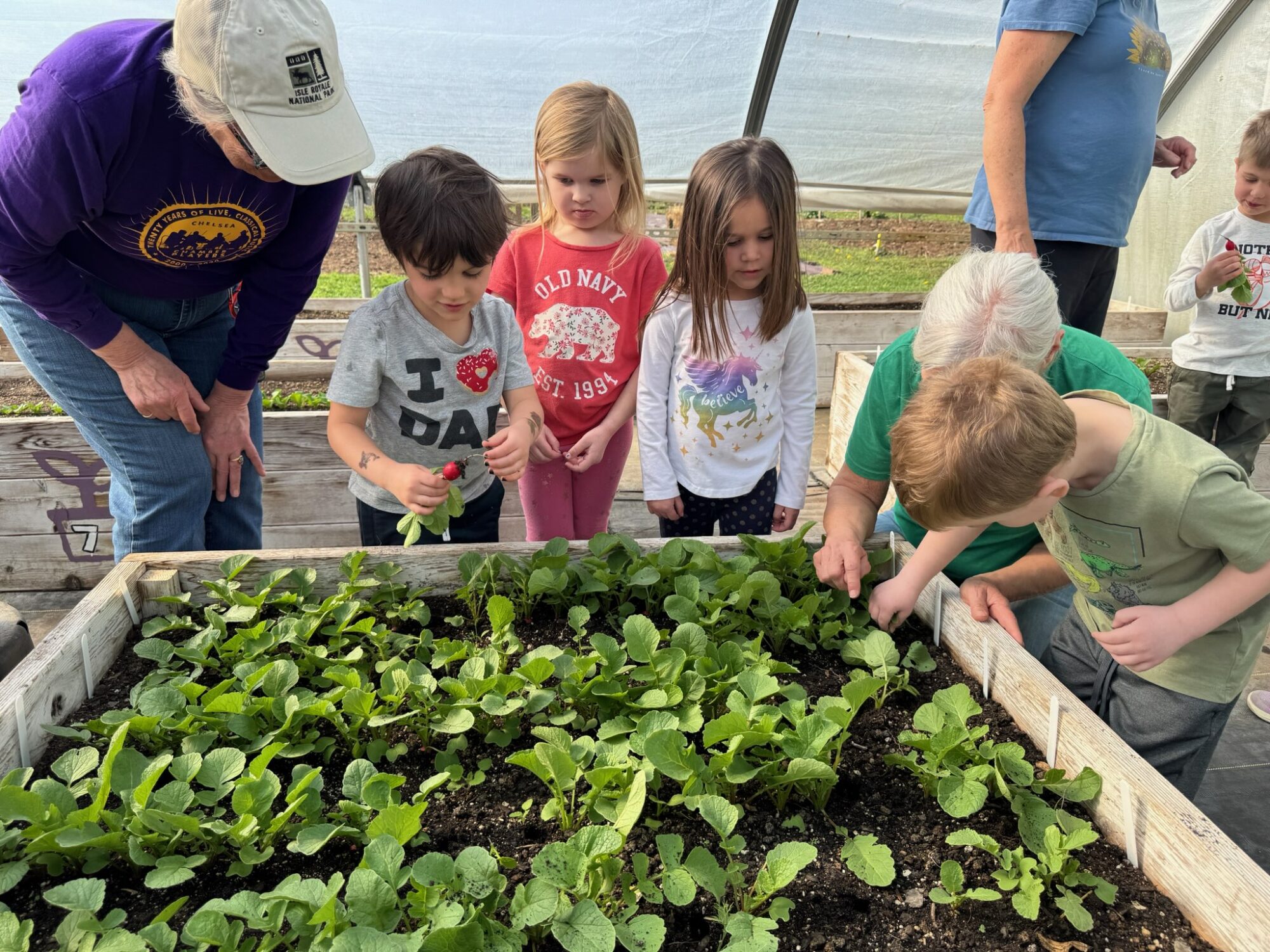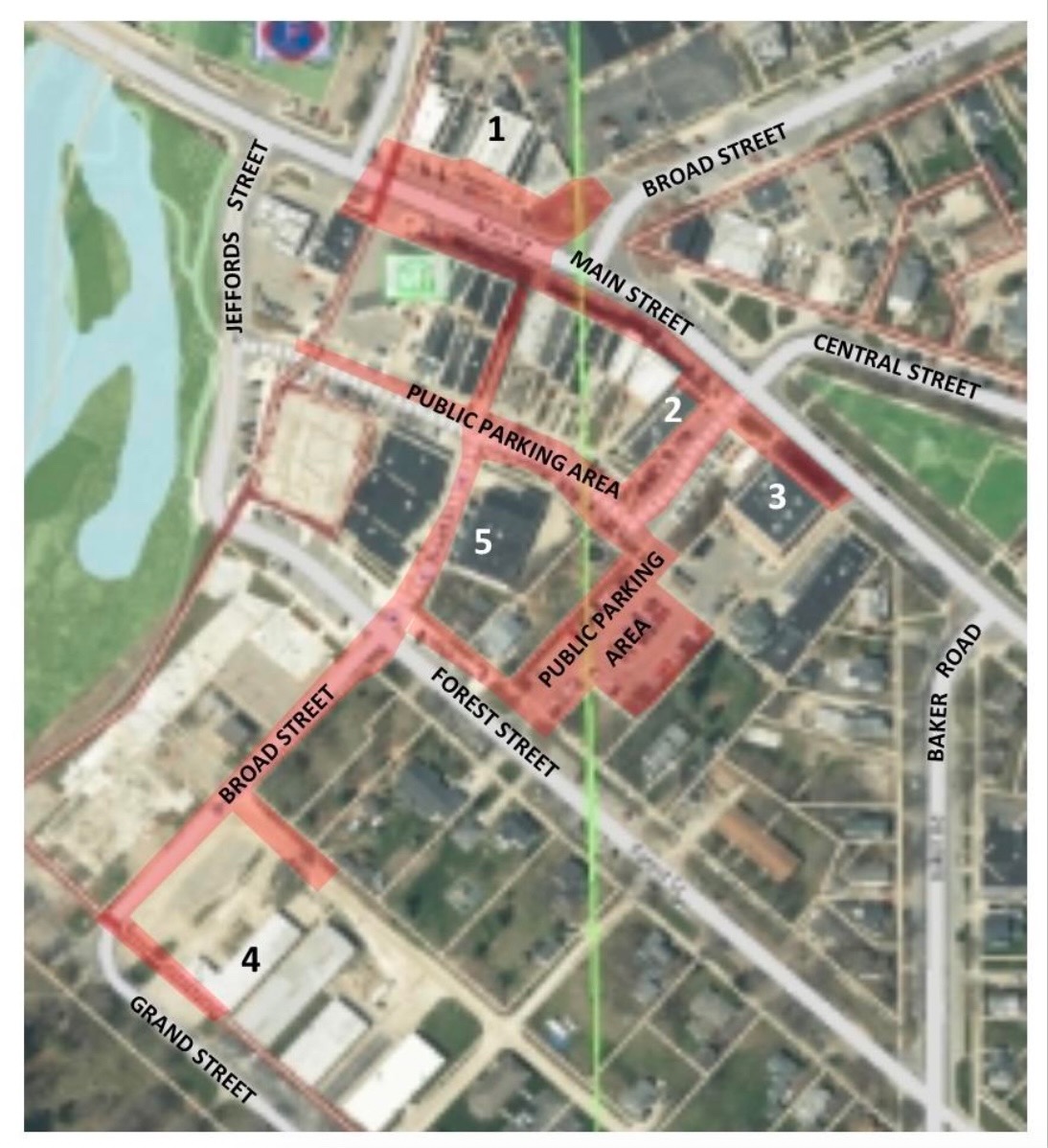Saline Resident Carolyn Kalmbach Beal reflects on 100 years of life and change
Photo: Carolyn Kalmbach Beal with her 104 birthday cards. Photo by Sue Kelch.
By Sue Kelch
If you are reading this, chances are you don’t remember what happened in 1924. The first Winter Olympics were held in France, and IBM was founded. J. Edgar Hoover was appointed to what would become the FBI, Ellis Island closed as an immigration entry point, and the first round-the-world flight was completed in 175 days.
And in 1924 Carolyn Kalmbach Beal was born, who just recently celebrated her 100th journey around the sun. I had the pleasure of meeting with her, and asked her to reflect on what she has experienced these past 100 years.
Carolyn’s Years Growing Up on the Farm
Carolyn was born to Oscar and Alma Kalmbach on July 2, 1924. Her grandparents came from Germany, so her parents were first-generation Americans. Her grandparents owned the farm she grew up on, which was later passed down to her father. She was the middle child of three daughters.

Keep in mind that when Carolyn was growing up, 27% of the population was engaged in farming in the United States. Today less than 1% are farmers. This speaks to the significance agriculture played in the economy and daily life.
Carolyn recollects, “My mother was a housewife and had nine brothers. When her father died her mother decided that she had to stay home and help feed and clothe those brothers. My mother always wished she had been able to finish high school, and after that, she said, ‘No daughter of mine is going to be without an education.’”
She adds, “My father graduated from high school at the age of 16 and he went right to work on a farm. Back in the early 1900’s it was unusual for a farm boy to graduate from high school.”
The farm they lived on was 4 miles west of Chelsea and was eventually broken up for the installation of I-94 in the late 1950s. Carolyn recalls “I remember waking up one morning and there were bulldozers coming over the hill from the west. That thing went all night, kaboom, kaboom. That road cut off our apple orchard which was on the other side.”

Their farm was mainly a dairy farm, but Carolyn says they also had “chickens and my mother sold eggs, and we had horses. Every year my dad would raise two pigs and then we would butcher them. You could make sausage patties or rings and put them in a crock and then fill it with lard. That would keep all winter without refrigeration, as we didn’t have a freezer.”
“Hams would be soaked in brine and then smoked in the smokehouse,” she adds. “Just hang them up in the woodshed after they were smoked, and they would keep for a year.”
“We always had a strawberry and raspberry patch and a few cherry trees,” Carolyn remembers. They would ship apples in barrels to North Dakota, and they also took apples to the Detroit farmer’s market.
“I learned to drive a tractor, and I drove a combine to cut wheat and cut corn, says Carolyn. “I had a driver’s license when I was 14 because if you lived on a farm back then you could get a driver’s license.”

She also remembers, “We had party phone lines growing up. Everyone’s phone would ring, and you paid attention to the ring to see if the call was for you. Our ring was three long and two shorts. If you picked up the phone and heard the neighbors talking, you couldn’t use it until they hung up. We had an old-style phone that hung on the wall.”
And, “My dad took a daily subscription to the Detroit Free Press. He also got the Saturday Evening Post. He had a radio, one of those you had to put on earphones. That’s how we got our news.”
Carolyn really enjoyed going to the country school. She recalls, “At the country school, we walked 1.5 miles each way. Henry Ford was very interested in the country school, and they would come once a week and bring cinnamon rolls.” She recalls one time, “We learned Scottish dancing. My mother made a kilt, and I think we went to Ann Arbor to do Scottish dancing performances.”

For recess, they would play baseball, and everyone would race outside to be the first batter. And although they didn’t have a sidewalk, they would draw in the dirt for hopscotch.
The Depression came in the early 1930s, and she recalls, “Since we lived on a farm, we never went hungry. We had enough to eat although the diet was monotonous. You didn’t go to town to buy anything that you could help.”
Carolyn explains, “Also we had a hired man that had been in the Civilian Conservation Corps (CCC). You can still see the trees in rows up north where they planted,” as one of the things the CCC did was reforestation. The CCC was a voluntary government relief program created between 1933-1942 for unemployed, unmarried men between the ages of 18-25 and was part of President F.D. Roosevelt’s New Deal.

After 8th grade, Carolyn went to Chelsea High School. Her dad brought her to school, as there weren’t any buses back then. “He milked his cows and then loaded up the milk and took it up to Chelsea to Weinberg’s Dairy. After school, I rode back home with a neighbor and gave him 50 cents a week for the ride.”
Carolyn’s Secondary Education and Marriage
True to her mother’s wishes, Carolyn received a high school degree and then secondary education. She went to Michigan Agricultural College – now Michigan State University (MSU), and then went on to graduate school in 1945 and took a year’s internship at the University of Iowa. “One of my professors at MSU knew about this program at Iowa where I could get a fellowship and both work and go to school half time. So that’s where I went. My job was working in a chemistry lab at Iowa Hospital at the Pediatrics Lab. I got a Master’s Degree in Child Welfare.”
This was quite an accomplishment – women pursuing higher education in the 1940s was not common – as only about 10% of enrolled students were women.
Carolyn’s Marriage and Family
Carolyn met Jim Beal when she was in high school. “We went together for a couple of years and then he got drafted. He was literally out of the country for almost four years. We didn’t get married until he returned. He was in the Army in New Guinea and the Philippines and was a radio operator. He later ended up in Japan. I think our Army was trying to do some reparations in Japan. That’s where he was when the war ended.”
She continues, “While I was in Iowa City, Jim came home from the Army. I finished my Master’s Degree, and we got married in 1946.” They started a family and moved back to Michigan, settling in Saline in 1949.
Carolyn and Jim had four children—two girls and two boys. After their last child was born, an administrator at Saline Hospital approached Carolyn and told her they needed a dietician. She accepted the offer and worked there for 27 years.
In 1952 Carolyn and her husband joined the Saline Methodist Episcopal Church (now the First United Methodist Church of Saline). They were active in the church, and became involved with the NOMADS, which stands for “Nomads On a Mission Active in Divine Service.” Some joke that it stands for “Nice Older Methodists Avoiding Deep Snow.”
Carolyn says, “We would go south to places like Texas, Georgia, Alabama, Arkansas, Florida. One thing we did was flood relief. They had a huge flood in Georgia, and you can’t rebuild after it’s been flooded until they’ve had time to take out the wet insulation. They have to disinfect that and then put in new insulation and new wallboards. And then we would come in and paint. Jim was a carpenter, and he was very welcome wherever we went; they always had a repair or something that needed to be done.”
She adds, “I recall one time we went to Jimmy Carter’s church in Georgia and attended his Sunday School. We had a picture taken with him and Rosalyn.”
Carolyn’s husband, Jim, has since passed away in 2008, and both of their daughters and Carolyn’s sisters have also passed away.
Carolyn celebrates 100
Reflecting on her life, I asked her what she had growing up that she wished young people could have now. Her quick response, “Time to play! Today’s children are so programmed with soccer practice and music practice and gymnastics. When I was young, we didn’t have that. I think they miss out on that now. They don’t learn how to entertain themselves.”

Many historical events happened in Carolyn’s lifetime: from the Depression to WWII, to the discovery of the polio vaccine, the building of the nation’s highway system, presidential assassinations, and the landing on the moon.
Considering all of this, I asked Carolyn who her favorite historical person was in her lifetime. Without hesitation, she responded, “Harry Truman. He had the tough job of ending the war. He was the right man for the job. I don’t know if anyone would have been that decisive or risked that much by making that decision.”
So, what does someone who is blessed with 100 years do for fun? Carolyn enjoys reading, bridge, walking, and playing Scrabble. She also enjoys visits from her large, extended family, which includes 11 grandchildren and 12 great-grandchildren.
And what is Carolyn’s advice for living a long life? “Don’t smoke, eat a balanced diet, and get exercise. The key is a positive attitude and staying on the sunny side of life. I think that’s important.”
As we were finishing up, Carolyn received yet another birthday card. She had hoped for 100 cards but had now accumulated 104. Staying on the sunny side, Carolyn beamed and said “Thank you.”
If you know someone who is celebrating their 36,500+ sunrises, here are some things you can do to make it extra special:
- Request a Presidential Greeting Request at www.whitehouse.gov/presidential-greeting
- Throw a Party with a theme of 100
- Make a Playlist of their favorite songs
- Create a video of messages from loved ones
- Write a list of 100 things you like about them
- Create a timeline of their achievements/milestones
- And, of course, feature them in a local newspaper article – like The Sun Times News






 8123 Main St Suite 200 Dexter, MI 48130
8123 Main St Suite 200 Dexter, MI 48130


